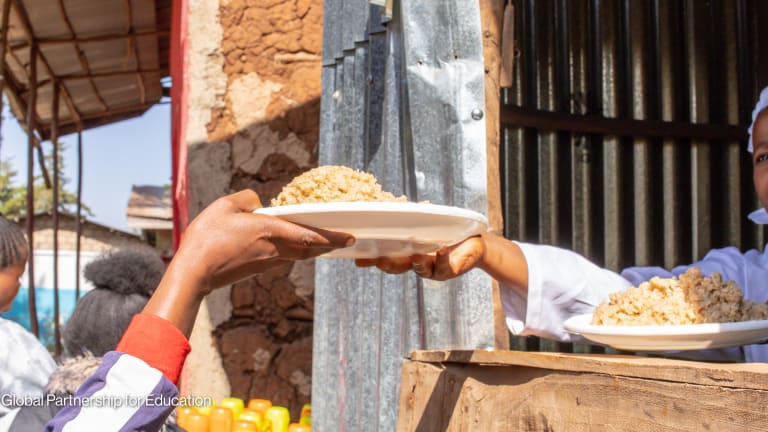
For Mia Sulastri, a young girl living in Borneo, Indonesia, getting the education she desperately needs to finish school has become a daily battle. Over the past two years, COVID-19 restrictions have forced her to take a long and risky 15-mile (24-kilometer) route by motorbike four times a week, just to get enough phone signal to receive WhatsApp messages from her teachers and email back her assignments. That’s time she could have spent studying — or playing.
Hers is an all-too-common story that is playing out all over the world, especially in marginalized and impoverished communities. In India, evidence shows that families with children who have suffered sexual abuse are experiencing even greater difficulties from a sudden loss of income and limited access to child support services due to the pandemic.
Part of our Focus on: Faith and Development
This series illuminates the role faith actors and their communities play in strengthening global development outcomes.
The COVID-19 crisis has rolled back decades of slow but steady progress in addressing the well-being of children and youths globally. In 2019, 1 billion children worldwide suffered at least one severe deprivation of life’s necessities — meaning they were without access to water, housing, nutrition, sanitation, or education. Today, 100 million more children have fallen into poverty. Beyond COVID-19, the consequences of armed conflicts and climate displacement are creating a mental health and violence crisis for young people everywhere.
Given this state of affairs, an all-out response must be mounted. Yet, despite the fact that a quarter of the world’s population is under 14, and an estimated 1.8 billion are aged between 10 and 24 — the largest generation of youths in human history — this demographic is not treated as a top priority in policy, programming, and funding around the world.
If children are our future, then the future looks bleak and all of us working in advocacy have an urgent duty to change this.
Getting our priorities straight
While decisions and initiatives that affect children are made every day across the U.S. government and U.S. Congress, there is a systemic failure to understand the direct and indirect impact of these decisions from the perspective of youths, whether they live in the United States or in countries around the world. At the Children’s Policy and Funding Initiative, we want to change this.
Three current U.S. policy priorities disproportionately impact children and youths: conflict, COVID-19, and climate change.
Major conflicts around the world have tripled since 2010, and at least one-fifth of youths live in conflict zones. The COVID-19 pandemic has caused severe backsliding of progress in education, as well as in the prevention of child sexual abuse and efforts to promote mental health and well-being.
An estimated 6.7 million children have lost a parent or caregiver to COVID-19, 1.8 billion children live in countries where violence prevention and response services have been severely disrupted, and the risks of child sexual abuse and severe malnourishment affect countless more children and youths who have been displaced by conflict.
Climate-related disasters are compounding these crises. Almost half of the world’s 2.2 billion children live in countries classified as “extremely high-risk” from impacts of climate change.
It is common sense to assert that these three “big C” policy focus areas — COVID-19, conflict, and climate change — would benefit from a fourth pillar: an additional “C” for children. This could help ensure that U.S. foreign assistance funding, policies, and programs, recognize the interconnected needs of young people and the central role they play in securing a better future for our world.
Investing strategically today can help build a better tomorrow for everyone. Children and youths who grow up safe, educated, and empowered have the potential to transform communities, societies, and nations for the better.
3 key areas of focus
Addressing child well-being cannot be a one-dimensional affair; it must also take into consideration all aspects of a child’s development. The central threads of care, education, and violence prevention are essential, but we also need to consider the more holistic tapestry of a child’s life: health and nutrition; safety and protection; mental and emotional well-being; equity and inclusion, and family care and legal rights.
This transformation will need leaders to work together across disciplines, interest sectors, and political ideologies. And the approach needs to focus on the whole lifespan of children from early childhood through adolescence and youth. To build the momentum to bring about an urgent shift in focus, we need to home in on three things.
First, we need to establish or strengthen senior leadership in all spheres of the U.S. government, by equipping decision-makers with resources and authority to ensure government-wide coordination that prioritizes children and youths globally.
Second, to elevate children and their interests in all policy and funding decisions it will be necessary to establish mechanisms to improve tracking and reporting of agency actions and expenditures.
For example, by requiring a child impact statement in evaluations of government policy and development programs through establishing a cross-agency priority to ensure federal funding positively impacts children and youths with data disaggregation for age, gender, disability, and other factors. This could especially make an impact on policy decisions affecting children globally.
Lastly, we need to engage young people directly in consultations — especially those most marginalized including girls, asylum-seekers and migrants, children in conflict settings, children with disabilities, orphaned children, LGBTQ children, minority and Indigenous children, and others.
A stronger future
Young people around the world are themselves leaders offering solutions. They are increasingly organized and speaking out to advocate for their needs. Fridays for Future, for example, is a youth-led and organized initiative to protest a lack of climate action. It began after Greta Thunberg and other young activists sat in front of the Swedish Parliament every school day for three weeks in 2018 and has grown to a youth movement of 14 million who are active in 7,500 cities worldwide.
By creating opportunities for youths to be heard and involved in decision-making processes, we can put in place more relevant and impactful policies to support them.
The U.S. has the capacity to support children both at home and in regions of the world that need it most and we need to use this to drive change and lay a stronger foundation for our children’s future. By working together, collaborating across sectors to create and implement a shared advocacy agenda, and committing resources to meet the holistic needs of children we can make a difference now and prevent dire consequences later.
The research is clear: Children exposed to trauma, violence, sexual abuse, insecurity, isolation, loss of care, and disrupted education, can experience long-term destruction to their physical, psychological, and social well-being.
Conflict, COVID-19, and climate change are disproportionately impacting child and youth well-being and will, in the long run, undermine the fabric of society and lead to further cycles of violence and conflict that uproot other key U.S. strategic initiatives. This is not a problem that we don’t have to worry about. It is something happening right now that affects the future for all of us.
Devex, with support from our partner GHR Foundation, is exploring the intersection between faith and development. Visit the Focus on: Faith and Development page for more. Disclaimer: The views in this article do not necessarily represent the views of GHR Foundation.









